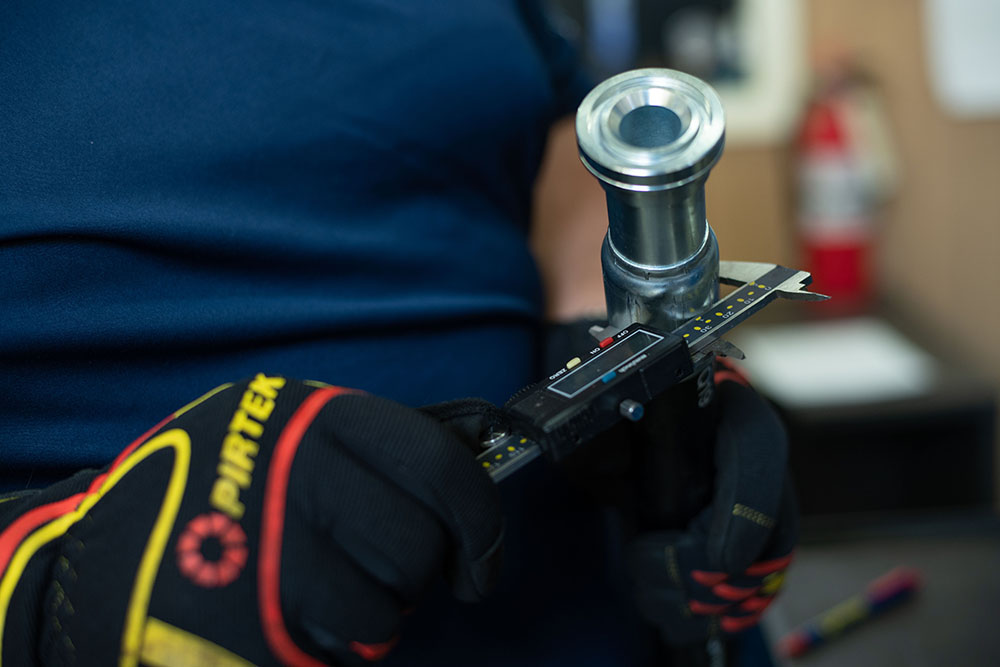The Importance Of Hydraulic Couplers In Industrial Machinery

Hydraulic couplers are crucial in industrial machinery, enabling efficient and safe fluid transfer between components. These essential devices, including hydraulic quick disconnect fittings and hydraulic quick connect fittings, have a significant impact on the performance and reliability of hydraulic systems. Hydraulic couplers help minimize downtime and improve overall operational efficiency by facilitating easy connections and disconnections.
This article explores the importance of hydraulic couplers in industrial applications. It examines the various types of hydraulic quick couplers, including threaded and flat face designs, and discusses their benefits, such as leak prevention, easy maintenance, and improved safety. The article also covers factors to consider when selecting the right hydraulic coupler, emphasizing compatibility, durability, and cost-effectiveness. By understanding the crucial role of hydraulic couplings, industry professionals can make informed decisions to enhance their machinery’s performance and reliability.
Understanding Hydraulic Couplers
Definition and Basic Function
Hydraulic couplers, also known as hydraulic couplings, are essential components in industrial machinery that allow for the swift connection and disconnection of hydraulic lines. These devices play a crucial role in facilitating efficient fluid transfer between various parts of hydraulic systems. Hydraulic couplers consist of two main parts: a male half and a female half. When properly connected, these halves form a secure, leak-free seal that enables the smooth flow of hydraulic fluid while containing internal pressures and resisting forces that might pull the joint apart.
The primary function of hydraulic couplers is to provide a convenient and time-saving method for attaching or detaching hoses and fittings in high-pressure hydraulic systems. This capability is particularly valuable in industries such as agriculture, construction, and manufacturing, where the ability to quickly change attachments or perform maintenance can significantly impact productivity and operational efficiency.
Types of Hydraulic Couplers
There are several types of hydraulic couplers, each designed to meet specific application requirements:
- Poppet-style couplers: These use a basic shut-off system that blocks fluid flow when disconnected and allows flow when connected by lifting the poppets off their seats.
- Flat-face couplers: These employ a more sophisticated interface, pushing face sections into each other when connected to open a large flow path. Flat-face hydraulic quick couplers are designed to eliminate fluid spillage during connection and disconnection, making them environmentally friendly and safer for operators.
- Threaded couplers: Also known as “thread-to-connect” couplers, these are specifically designed to resist bending effects and eliminate premature wear. They are suitable for heavy-duty applications and high-pressure environments.
- Agricultural (pioneer) couplers: These use two check balls that open to allow oil flow when pushed against each other upon connection.
- Multi-coupling plates: These allow for the simultaneous connection of multiple hydraulic lines with a single motion, often used in equipment with several hydraulic circuits.
Key Components and Design Features
Hydraulic couplers incorporate several key components and design features that contribute to their functionality and reliability:
- Valve types: Couplers may use different valve designs, including ball, poppet, or flat-face valves. Each type offers specific advantages in terms of flow characteristics, sealing capabilities, and resistance to contamination.
- Locking mechanisms: These ensure a secure connection between the male and female halves, preventing accidental disconnection during operation.
- Seals and O-rings: High-quality, oil-resistant seals are crucial for maintaining a leak-free connection and preventing fluid loss.
- Materials: Hydraulic couplers are typically made from durable materials such as steel, brass, or aluminum alloys to withstand high pressures and harsh operating conditions.
- Flow capacity: The design of the coupler affects its flow capacity, with flat-face couplers generally offering a more significant flow path and reduced pressure drop compared to poppet-style couplings.
- Contamination resistance: Some designs, like flat-face couplers, offer superior resistance to contamination, making them easier to clean and maintain.
- Pressure ratings: Different coupler designs can accommodate varying pressure levels, with some specialized types capable of handling very high pressures.
- Connection methods: Couplers may feature different connection mechanisms, such as push-to-connect, screw-to-connect, or sleeve retraction designs, each offering specific advantages in terms of ease of use and security.
Understanding the various types, components, and design features of hydraulic couplers is crucial for selecting the right coupling for specific applications. The choice of hydraulic quick-connect fittings can significantly impact system performance, maintenance requirements, and overall operational efficiency in industrial machinery.
Benefits of Hydraulic Couplers in Industrial Applications

Increased Efficiency and Productivity
Hydraulic quick couplers have a substantial impact on operational efficiency. By enabling swift attachment changes, these devices eliminate the need for time-consuming manual removal of mounting pins. This capability is particularly valuable in industries such as agriculture, construction, and manufacturing, where the ability to quickly switch between attachments can significantly boost productivity.
Consider a scenario where an operator needs to change attachments multiple times throughout the day. Traditional manual changes can take up to 20 minutes each time. However, this process is drastically reduced with hydraulic quick couplers, often taking just a few seconds. This time-saving feature allows operators to transition between tasks seamlessly, maximizing equipment utilization and overall productivity.
Moreover, hydraulic couplers enhance versatility by allowing a single machine to perform various functions with different attachments. This flexibility enables businesses to adapt quickly to changing job requirements, ultimately improving project timelines and resource allocation.
Reduced Downtime and Maintenance Costs
One of the most significant benefits of hydraulic couplers is their ability to minimize equipment downtime. Quick-release couplings facilitate rapid connection and disconnection of hydraulic lines without the need for specialized tools. This feature is particularly advantageous during routine maintenance or when addressing unexpected issues.
By reducing the time required for attachment changes and maintenance procedures, hydraulic couplers help keep machinery operational for longer periods. This increased uptime translates directly into improved productivity and reduced operational costs.
Furthermore, hydraulic couplers contribute to lower maintenance costs in several ways:
- Simplified maintenance procedures: The ease of disconnecting and reconnecting hydraulic lines allows for quicker and more efficient maintenance routines.
- Reduced wear and tear: Proper use of hydraulic couplers can minimize stress on hydraulic components, potentially extending their lifespan.
- Prevention of contamination: Many hydraulic quick couplers feature designs that help prevent contaminants from entering the hydraulic system during connection and disconnection, reducing the risk of system damage and associated repair costs.
Enhanced Safety and Leak Prevention

Advanced hydraulic coupler designs incorporate various safety features to prevent accidental disconnections and potential injuries. For instance, some systems include visual indicators, such as LED lights or warning buzzers, to confirm proper engagement. These features help operators manage the system more effectively and prevent hazardous situations that could arise from improperly attached equipment.
Leak prevention is another crucial aspect of hydraulic coupler benefits. High-quality hydraulic quick-connect fittings are designed to create secure, leak-free connections even under high-pressure conditions. This capability is essential for maintaining system integrity, preventing fluid loss, and avoiding potential environmental contamination.
Some hydraulic couplers, such as flat-face designs, offer superior resistance to contamination and are easier to clean and maintain. This feature not only enhances the overall reliability of the hydraulic system but also contributes to improved safety by reducing the risk of slip hazards caused by oil leaks.
In conclusion, hydraulic couplers offer a range of benefits that significantly enhance the performance, efficiency, and safety of industrial machinery. By facilitating quick attachment changes, reducing downtime, lowering maintenance costs, and improving safety measures, these components play a vital role in optimizing industrial operations across various sectors.
Selecting the Right Hydraulic Coupler
Choosing the appropriate hydraulic coupler is crucial for ensuring optimal performance and longevity of industrial machinery. Several factors need to be considered when selecting hydraulic quick-connect fittings to guarantee compatibility, durability, and efficiency in various applications.
Factors to consider
When selecting hydraulic couplers, it’s essential to take into account the following key factors:
- Compatibility: Ensure that the chosen hydraulic quick disconnect fittings are compatible with your existing system components. This includes checking for proper thread sizes, port types, and connection methods.
- Pressure rating: Consider the maximum operating pressure of your hydraulic system and select couplers that can withstand these pressures. Different coupler designs offer varying pressure ratings, ranging from 3,000 PSI to 10,000 PSI for high-pressure applications.
- Flow capacity: Evaluate the required flow rate for your application and choose hydraulic quick couplers that can accommodate the necessary fluid flow without causing significant pressure drops.
- Environmental conditions: Consider the operating environment, including temperature ranges and exposure to corrosive substances. This will help determine the most suitable materials and protective treatments for your hydraulic couplings.
- Frequency of connection/disconnection: If frequent coupling and uncoupling are required, opt for designs that facilitate easy maintenance and minimize downtime, such as push-to-connect or quick-release mechanisms.
- Leak prevention: Select hydraulic quick-connect fittings with reliable sealing mechanisms to prevent fluid loss and maintain system integrity. Flat-face designs, for example, offer superior leak prevention and contamination resistance.
- Cost-effectiveness: While initial costs are important, consider the long-term value of the hydraulic couplers, including their durability, maintenance requirements, and potential impact on overall system efficiency.
Material Options and their Properties
The choice of material for hydraulic couplers significantly impacts their performance and longevity. Common materials include:
- Carbon steel: This is the most widely used material for hydraulic quick couplers due to its strength, durability, and cost-effectiveness. Carbon steel couplings are suitable for many manufacturing applications but may require additional protective treatments in corrosive environments.
- Stainless steel: Offering excellent corrosion resistance, stainless steel hydraulic couplings are ideal for harsh environments and applications involving corrosive fluids. Different grades of stainless steel, such as 316 and 304, provide varying levels of corrosion resistance and strength.
- Brass: Known for their good resistance to medium-level corrosive fluids, brass hydraulic quick-connect fittings are easy to work with and offer reliable performance in certain applications.
To enhance corrosion resistance and durability, various protective treatments can be applied to hydraulic couplers, including:
- Chrome III: A surface galvanizing treatment using zinc and chromium, significantly increasing resistance to corrosion.
- Zinc-Nickel: An alternative surface galvanizing treatment that improves corrosion resistance.
- QPQ (Quench Polish Quench): A heat treatment that combines surface hardness with good corrosion resistance.
Size and Port Type Considerations
Selecting the appropriate size and port type for hydraulic quick couplers is crucial for ensuring proper fit and function within your hydraulic system. Consider the following:
- Size: Hydraulic couplers are available in various sizes, typically ranging from 1/4 inch to 2 inches. Choose a size that matches your system’s requirements and flow capacity needs.
- Port types: Common port options include:
-
- NPT (National Pipe Thread)
- SAE (Society of Automotive Engineers)
- BSPP (British Standard Parallel Pipe)
- Metric threads
-
- Connection methods: Different coupling designs offer various connection methods, such as:
-
- Push-to-connect
- Screw-to-connect
- Sleeve retraction
- Push-pull
-
- Valve types: Consider the valve design that best suits your application:
-
- Poppet valves: Offer high mechanical resistance and reliable sealing
- Ball valves: Provide good flow characteristics
- Flat face valves: Ensure minimal spillage and contamination resistance
-
By carefully considering these factors, materials, and design options, you can select hydraulic couplers that offer optimal performance, reliability, and cost-effectiveness for your specific industrial machinery applications.
Conclusion
Hydraulic couplers have a significant impact on the efficiency and reliability of industrial machinery. Their ability to enable quick connections and disconnections, prevent leaks, and enhance safety makes them essential components in various sectors. The selection of the right hydraulic quick-connect fittings, taking into account factors such as compatibility, pressure ratings, and environmental conditions, is crucial to optimize system performance and longevity.
As technology continues to advance, hydraulic couplers are likely to play an even more vital role in improving industrial processes. Their ongoing development promises to bring about further enhancements in productivity, safety, and cost-effectiveness across numerous industries. To explore the latest innovations in hydraulic coupler technology and find the perfect solution for your needs, visit www.pirtekusa.com to get your Hydraulic Coupler.
FAQs
What does a hydraulic coupler do?
Hydraulic quick couplers facilitate the rapid connection and disconnection of hydraulic hoses. They eliminate the need for additional tools and procedures like bleeding the system, closing valves, purging trapped gasses and pressures, or recharging fluids.
Why are hydraulic systems important in industrial settings?
Hydraulic systems enhance control over machinery, significantly reducing time wastage and errors during production. They allow for easy integration of new products into existing manufacturing lines with minimal adjustment required.
What role do hydraulic fittings play in hydraulic systems?
Hydraulic fittings are crucial for connecting multiple hoses or components, enabling more complex configurations in hydraulic systems. Flange fittings, for instance, connect hoses or components to a flanged surface and are essential for creating a secure, leak-free connection in high-pressure environments.



